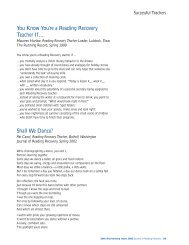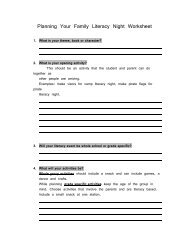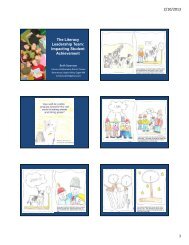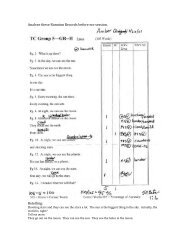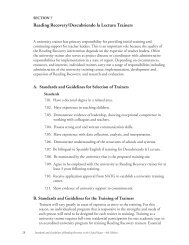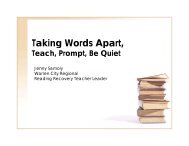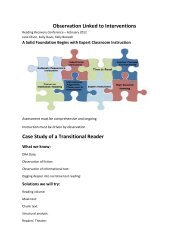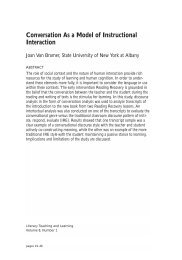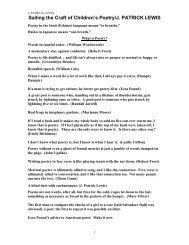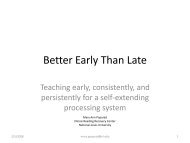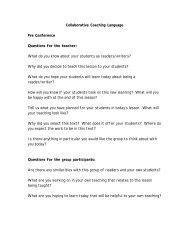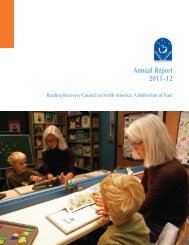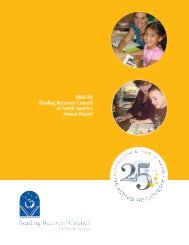Noel Jones - Attending to Word Learning: Refining the Focus
Noel Jones - Attending to Word Learning: Refining the Focus
Noel Jones - Attending to Word Learning: Refining the Focus
You also want an ePaper? Increase the reach of your titles
YUMPU automatically turns print PDFs into web optimized ePapers that Google loves.
Brief Overview<br />
Expanding <strong>the</strong> focus: Multi-tasking<br />
Changing <strong>the</strong> focus over time:<br />
Early in <strong>the</strong> lesson series<br />
Mid-way through <strong>the</strong> series<br />
Late in <strong>the</strong> lesson series<br />
<strong>Attending</strong> <strong>to</strong> <strong>Word</strong> <strong>Learning</strong>:<br />
Refocusing Attention <strong>to</strong> Foster Growth<br />
<strong>Noel</strong> <strong>Jones</strong> – UNCW Trainer Emeritus<br />
The Challenge of: Multi-tasking:<br />
Teachers must focus on several things at one time:<br />
• The meaning of <strong>the</strong> s<strong>to</strong>ry and how <strong>the</strong> child is responding <strong>to</strong> <strong>the</strong> meaning<br />
• Observing <strong>the</strong> child’s processing (watching how he is working)<br />
• Recording significant attempts, solves, and miscues, behaviors<br />
• Providing assistance (scaffolding)<br />
• Analyzing lesson records (after lesson)<br />
<strong>Word</strong> <strong>Learning</strong> within Clay’s Theory . . .<br />
Teachers need <strong>to</strong> move beyond <strong>the</strong> idea that learning <strong>to</strong> read, or that learning words, is a matter of<br />
committing words <strong>to</strong> memory. Becoming literate is a process of forming complex connections in <strong>the</strong><br />
brain - an interactive networks of strategies and sub-components through which (<strong>the</strong> child) learns<br />
• how <strong>to</strong> process visual information<br />
• how <strong>to</strong> process phonological information<br />
• <strong>to</strong> form complex connections between <strong>the</strong> two (LL Part II, 205 p. 123)<br />
Clay on Literacy <strong>Learning</strong><br />
(A beginner) attends <strong>to</strong> many different aspects of printed texts (letters, words, language, messages,<br />
and s<strong>to</strong>ries.) He will have limited knowledge and primitive early response patterns in each of <strong>the</strong>se<br />
areas (which will) change …as he learns more about each area, and as <strong>the</strong> child learns <strong>to</strong> work on <strong>the</strong><br />
interrelationships of <strong>the</strong>se areas. (Clay 2005a, p. 19, Paraphrased)<br />
Establishing foundations, which include:<br />
• Age-appropriate control of language<br />
• Interest in s<strong>to</strong>ries<br />
• Concepts about print<br />
• Letter identification<br />
• Building a bank of known words/letters<br />
• Left-right sequential visual processing<br />
• Phonemic awareness<br />
• Coordinating visual and audi<strong>to</strong>ry processing<br />
Early in <strong>the</strong> Lesson Series
Questions about Early <strong>Word</strong> <strong>Learning</strong> Progress<br />
What does <strong>the</strong> child know<br />
(letters, words, concepts about print, use of space, etc.)<br />
How does <strong>the</strong> child know it<br />
(as a memorized string, by a single feature, as a mo<strong>to</strong>r program, etc.)<br />
How well does <strong>the</strong> child know it<br />
(See <strong>the</strong> first <strong>Word</strong> Journey below – correct controlled, etc.)<br />
How does <strong>the</strong> child use what he knows<br />
(Does he recognize it in print does he moni<strong>to</strong>r etc.)<br />
<strong>Word</strong> <strong>Learning</strong>: The Three Journeys<br />
Journey one (Unknown <strong>to</strong> known)<br />
New (never seen before)<br />
Just known (seen or worked with before)<br />
Partially controlled (working for a solution)<br />
Controlled production but with lapses<br />
Controlled, correct (requires attention)<br />
Fast, fluent (almost no attention required)<br />
Journey two Slow <strong>to</strong> fast responding<br />
Journey three<br />
From slow and conscious, <strong>to</strong> fast au<strong>to</strong>matic<br />
The word finds its place within <strong>the</strong> child’s literacy knowledge about o<strong>the</strong>r words,<br />
phrases and meanings <strong>the</strong> child knows<br />
Expanding Meager Knowledge of <strong>Word</strong>s<br />
The object is twofold:<br />
• Expanding knowledge of ‘known’ words<br />
• <strong>Learning</strong> how <strong>to</strong> learn words<br />
Selecting words for early learning<br />
<strong>Word</strong> learning activities in writing: tracing, writing, looking, visualizing (Journey One) Repeated<br />
writing (Journey Two)<br />
Practice word remembering and retrieval<br />
Using mag. letters <strong>to</strong> break known words and <strong>to</strong> foster left-right sequential processing<br />
Develop concepts: word, letter, first, last<br />
Strategic activities with words in reading (locate, moni<strong>to</strong>r, check, search)<br />
Observing and recording reading/writing vocabularies
Assisting with Memory and Retrieval<br />
Activities that can help young children establish mental representations and retrieve information:<br />
Movement activities (tracing, writing, ML’s)<br />
Use of various media, surfaces, and contexts<br />
Visualizing (seeing with <strong>the</strong> eyes closed)<br />
Recall, divert attention, recall again<br />
“Echoes across <strong>the</strong> lesson (don’t overdo it)”<br />
Helping Children intend <strong>to</strong> remember<br />
Using verbal prompts or specific associations<br />
Repetition and over-learning<br />
Massive amounts of reading and writing<br />
Breaking <strong>Word</strong>s: An early sequence with ML’s<br />
Known words for directionality and sequence (19-20)<br />
Known words for word concepts (42-43, & 140-141)<br />
Known words: words can be broken in<strong>to</strong> parts in more than one way (pp. 43-45)<br />
• word endings<br />
• breaks within words (can be onset and rime)<br />
A child needs <strong>to</strong>:<br />
establish left-right sequential visual scanning<br />
know that words are made up of letters<br />
understand words can be broken in different ways<br />
Then he is ready <strong>to</strong> see parts he knows within words<br />
This establishes <strong>the</strong> base for <strong>the</strong> child <strong>to</strong> start solving words later in <strong>the</strong> lesson series, both in reading<br />
and in writing, using analogies <strong>to</strong> known words & parts<br />
[Record what you do and how <strong>the</strong> child performs]<br />
Hearing/Recording Sounds in <strong>Word</strong>s<br />
• Critical role in strategic activity in both reading and writing<br />
• Attend <strong>to</strong> <strong>the</strong> process, not accuracy – what counts is <strong>the</strong> child’s awareness of sounds within<br />
his words<br />
• Accept approximations – Be sensitive <strong>to</strong> child-like forms, and dialects<br />
• Don’t keep children at <strong>the</strong> same level <strong>to</strong>o long<br />
Task independence<br />
Random vs. sequential order<br />
Copying vs. writing in <strong>the</strong> s<strong>to</strong>ry<br />
• Foster flexibility in solving words (LL 59-60)<br />
Write quickly a word you know<br />
Write <strong>the</strong> sounds you hear
Reading in Early Lessons<br />
The goals: – <strong>Learning</strong> <strong>to</strong> look at print; learning more about letters and words; and relating what<br />
you say <strong>to</strong> what you see<br />
Remember: focus on meaning is primary<br />
Early strategic activity<br />
1 : 1 matching<br />
Locating known/unknown words<br />
Moni<strong>to</strong>ring, <strong>Learning</strong> <strong>to</strong> check<br />
Searching<br />
Teacher scaffolding<br />
Preparation (Book introductions, etc.)<br />
Prompting : Prompt for known information<br />
Start from least helpful prompt<br />
Give help when needed<br />
Important Principles for Early <strong>Learning</strong><br />
• Target instruction <strong>to</strong> <strong>the</strong> child’s knowledge<br />
• Be consistent and persistent (teach for shifts in child’s understanding and performance)<br />
• <strong>Word</strong>s should arise from reading and writing<br />
• Carefully plan and evaluate your teaching<br />
• Ensure ‘echoes’ throughout <strong>the</strong> lesson<br />
• Arrange for continuous learning across lessons<br />
• Be sensitive <strong>to</strong> <strong>the</strong> child’s language and speech<br />
Midway in <strong>the</strong> Lesson Series<br />
Three goals:<br />
1. Linking sound sequences with letter sequences<br />
(Coordinating sequential visual analysis with sequential phonological analysis while<br />
orchestrating information from all sources)<br />
2. Providing ways of accessing new vocabulary<br />
(Searching and problem-solving while reading and writing)<br />
3. Extending knowledge of how words work<br />
(The third Journey in <strong>Word</strong> <strong>Learning</strong>)<br />
1. Linking Sound Sequences with Letter Sequences<br />
The basics:<br />
All of <strong>the</strong> foundation areas in early learning:<br />
Hearing and recording sounds in words<br />
Sequential L→R visual analysis of letters/words<br />
Linking <strong>the</strong> analysis of letters you are seeing (L-R) <strong>to</strong> <strong>the</strong> sound sequences in <strong>the</strong> word you<br />
are hearing in your head
Ways of promoting L→R visual analysis:<br />
• Breaking known words with ML’s<br />
• Use a “slow check” on words <strong>to</strong> confirm or search<br />
• Use prompts that ask him <strong>to</strong> think about information of all types (or <strong>the</strong> type that’s ignored)<br />
• Use a masking card <strong>to</strong> reveal <strong>the</strong> word gradually, in L-R sequence (Make sense, Look right)<br />
• All <strong>the</strong>se are slow demonstrations, but <strong>the</strong> goal is fast processing<br />
Three things <strong>to</strong> watch for<br />
Consistent habitual L-R visual processing<br />
Ability <strong>to</strong> identify sounds in sequence (ability <strong>to</strong> go from sounds <strong>to</strong> letters)<br />
Ability <strong>to</strong> go from letters <strong>to</strong> sounds (now in <strong>the</strong> special problems section in LL)<br />
2. Providing access <strong>to</strong> new vocabulary<br />
…In writing<br />
• Repeated writing of words (Journey #2)<br />
• Hearing and recording sounds in words<br />
-- More sounds identified and recorded<br />
-- Move <strong>to</strong> sequential analysis<br />
-- Notice letter clusters or combinations<br />
-- Move <strong>to</strong> letter boxes<br />
-- Transfer <strong>the</strong> process <strong>to</strong> <strong>the</strong> s<strong>to</strong>ry page<br />
• Make it like a word you know<br />
Make it Like Ano<strong>the</strong>r <strong>Word</strong> You Know – Scaffolding<br />
Most help Help as needed Less help<br />
Teacher tells similarity<br />
(“Starts like... ends like…<br />
sounds like…”)<br />
Teacher tells word (You know<br />
“x”)<br />
Teacher helps connect<br />
Thinks of <strong>the</strong> sound, and<br />
writes letters<br />
Teacher tells similarity (“Do<br />
you know a word that starts<br />
like… ends like… sounds like<br />
that”)<br />
Helps with word & connection<br />
if needed<br />
Child thinks of word, makes<br />
connection, writes letter<br />
Prompts child <strong>to</strong> think of a<br />
word: (Do you know a word<br />
that can help”)<br />
(If needed, suggest similarity<br />
(“Do you know a word that<br />
starts like that)<br />
Child thinks of word, makes<br />
connection, writes letters.<br />
Variations: A word that ends like that…a word that rhymes with “x”….A word that<br />
sounds like that….A word that looks like that ….A word like that
… in Reading<br />
“RR teachers have <strong>to</strong> change passive readers in<strong>to</strong> readers who search actively for information in<br />
print that can help <strong>the</strong>m. “Two things help…<br />
• <strong>the</strong>y try out possible responses<br />
• and <strong>the</strong>y learn <strong>to</strong> verify <strong>the</strong>ir decisions” (LL p. 102)<br />
Trying out possibilities (Searching)<br />
Preparation for reading – book introductions, etc<br />
TTA and think what would make sense (M,S) and/or start with those letters (V) or sounds (Ph)<br />
Prompts <strong>to</strong> visual features that <strong>the</strong>y know and know how <strong>to</strong> use (LL pp 132-133)<br />
Cautions about prompting. (LL part I, p.38-39)<br />
Verifying decisions (often under-emphasized)<br />
• Checking prompts (make sense sound right look right<br />
Notice <strong>the</strong> note on p. 124 … (If he can move easily from sounds <strong>to</strong> letters or letters <strong>to</strong><br />
sounds…)<br />
• Taking words apart after reading<br />
• Teaching on successful solving<br />
• Make sure <strong>the</strong> child makes independent decisions based on what he knows and what he sees<br />
in <strong>the</strong> text<br />
Scaffolding <strong>to</strong>ward independence<br />
Based upon thoughtful analysis<br />
Teach <strong>to</strong> what <strong>the</strong> child is beginning <strong>to</strong> notice<br />
Use <strong>the</strong> scale of help on pp. 132-133<br />
Using a word you know <strong>to</strong> solve a new word<br />
The known word needs <strong>to</strong> be well known<br />
Think about what <strong>the</strong> child can do in writing and in reassembling <strong>the</strong> cut-up sentence<br />
If needed, demonstrate with magnetic letters<br />
Keep teacher talk <strong>to</strong> a minimum<br />
Allow minimal interruption of text reading<br />
3. Extending knowledge of how words work<br />
…in Writing<br />
• Letter formation and writing conventions<br />
• Transition <strong>to</strong> letter boxes<br />
• Information about spelling quirks<br />
• Make it like a word you know<br />
… in Reading<br />
• Taking words apart after reading<br />
• Prompts for strategic activity (moni<strong>to</strong>ring, searching, checking, confirming)<br />
• Teaching points <strong>to</strong> unsnarl confusions or <strong>to</strong> demonstrate
… <strong>Word</strong> Work<br />
Breaking words (LL pp. 140-143)<br />
Continue <strong>to</strong> check on L-R sequential analysis<br />
Breaking words in<strong>to</strong> parts<br />
Any kind of break <strong>the</strong> child makes<br />
<strong>Word</strong> endings, clusters, onset and rime<br />
Comparing words, seeing similarities<br />
Changing words:<br />
Substituting initial letters;<br />
Change <strong>the</strong> onset – retain <strong>the</strong> rime<br />
Retain <strong>the</strong> onset – change <strong>the</strong> rime<br />
Working this in<strong>to</strong> <strong>the</strong> lesson framework<br />
Choosing examples<br />
Basic principle: follow <strong>the</strong> child<br />
Build from known <strong>to</strong> new<br />
Before or after encounters in writing/reading<br />
Later in <strong>the</strong> Lesson Series<br />
Meaning is still paramount<br />
Fast processing in reading and writing<br />
Flexible and fluent with strategic activities<br />
Solving <strong>Word</strong>s by Analogy<br />
After HSIW and breaking words are well under control<br />
Taking parts of two known words <strong>to</strong> form a new word<br />
<strong>Word</strong>s must be really well known so that borrowing from <strong>the</strong>m requires little attention<br />
<strong>Word</strong>s used should be productive and regular<br />
Demonstrate and show; talk only <strong>to</strong> point <strong>to</strong> things.<br />
The focus is on <strong>the</strong> visual (V) and sound (Ph). Correctness decisions involve all cues<br />
Be clear about prompting for looking (in reading, “a word that looks like that”), or hearing (in<br />
writing, “a word that sounds like that)
Opportunities for solving (non-verbal)<br />
Providing support for learning<br />
In RR learning occurs as an outcome of problem solving through strategic activities in reading<br />
and writing texts. (Clay 1991, pp. 340-345)<br />
Many words are learned entirely or partially through this means. Judicious teaching can build<br />
upon and extend <strong>the</strong> partial knowledge. The challenges and opportunities you present are key<br />
Demonstration (non-verbal)<br />
Much more powerful than explanation. Work slowly. Any accompanying language should be<br />
like a pointer – going clearly straight <strong>to</strong> <strong>the</strong> mark<br />
Teaching (verbal and non-verbal)<br />
Telling <strong>the</strong> child something or showing how <strong>to</strong> do something new that builds on current<br />
knowledge<br />
Make it very clear <strong>to</strong> <strong>the</strong> child what he needs <strong>to</strong> be attending <strong>to</strong> -- visual form, sound, letter,<br />
word, order or sequence. (See Clay 2005a, p. 40)<br />
Prompting (verbal)<br />
“A prompt is a call for action <strong>to</strong> do something within his control” “Too much prompting<br />
(help) interferes with <strong>the</strong> development of independent solving” (LL p 39)



